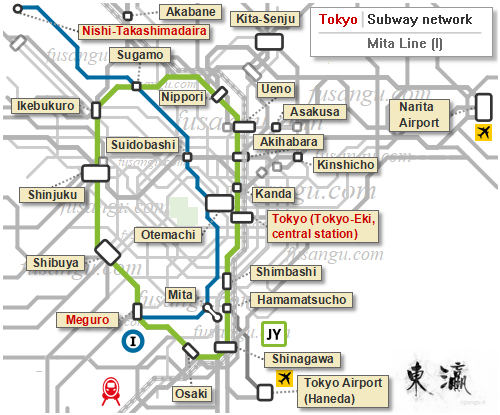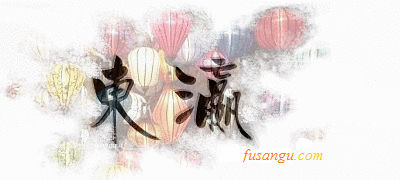
The Mita-sen is one of the four subway lines managed by Toei, Tokyo’s municipal transportation company.
The long line describes a semicircular path along a north-south route. In the centre the line connects some of the city’s most popular tourist areas such as Bunkyo, Chiyoda, Minato and Meguro.
In this page we describe a one-day tour along the Mita Line. The article includes programmes that are suitable for those who are in Tokyo for periods longer than 3-4 days.
The Mita Line passes through some of the most important neighbourhoods in the centre of Tokyo. The line intersects twice the JR Yamanote Line (the railway loop line) in Meguro and Sugamo.
While very effective in linking areas of the centre, the line is most often used by visitors who stay in Tokyo for periods longer than 4-5 days. This is because the line is particularly useful to those who visit Bunkyo and Minato, areas that are often included in long stays.
Major stations along the Mita Line
The Mita Line is runs along a north-south direction. Between Sugamo and Meguro, namely in the section of utmost interest for a visitor, the line describes a semi-circular route through the core of the city centre, i.e., Hibiya.
Station to be noted are at least the following (from north to south):
-
Sugamo, a small neighbourhood known as the “Harajuku of the Elderly”. The station is also served by the Yamanote Line. Rikugi-En, one of Tokyo’s most beautiful gardens, is very close to Sugamo Station;
-
Kasuga, in the centre of Bunkyo District, a major transfer station (connection with Marunouchi, Namboku and Oedo lines). The station is close to Koishikawa Koraku-En, a magnificent garden. Very close are also Kodokan, Japan’s Judo headquarters and Tokyo Domu, an entertainment complex;
-
Suidobashi, a station that gives access to Kanda, a interesting neighbourhood in the centre of Tokyo. Near the station are some of Tokyo’s most prestigious universities as well as Ochanomizu and Jimbocho areas. Many good value for money mid-range hotels are located near this station;
-
Jimbocho, a neighbourhood famous for the presence of large shops selling musical instruments and bookshops. Connection with Shinjuku and Hanzomon lines;
-
Otemachi, huge station served by four more lines (Marunouchi, Tozai, Chiyoda, Hanzomon lines).Tokyo Station, the city’s central railway station, can be reached on foot via an underground passage;
- Hibiya: near the Imperial Palace, Hibiya Park and some of the city’s most prestigious hotels (Imperial Hotel, Peninsula Hotel);
-
Shibakoen, near Shiba Park, in Minato District. Here are Zojo-Ji Temple and Tokyo Tower (a communication and observation structure, vaguely resembling a small Eiffel Tower). Not to be missed is also Shiba Tosho-gu, a beautiful shrine built with the distinctive Toshogu style. The park is also home to an ancient ginkgo tree, believed to have been planted by Tokugawa Iemitsu himself.
-
Meguro, main station of the district. The station is not far from Meguro-gawa, a must-see cherry blossom spot. Connection with Yamanote Line.
Recommended itineraries along the Mita Line
Below we give brief descriptions of two interesting itineraries along the Mita Line. We have focused on destinations that are particularly interesting to those who visit Tokyo for the first time.
From Sugamo to Meguro through Bunkyo and Minato
Below is a programme with starting point in Sugamo, station conveniently served by the Yamanote Line (loop line).
Choosing a different sequence of visits poses no difficulty. The programme is very suitable also for those who wish to find accommodation in the centre of Tokyo (Kanda, Marunouchi, Akasaka).
As a few rides are needed, we suggest you buy a subway day pass.
Programme:
-
9:00 - 10:00: a short walk from Sugamo Station takes to Rikugi-En garden, a wonderful landscape gardens comprising 88 scenes of ancient poetry;
-
10:00 - 13:00: transfer to Kasuga Station. You can then reach on foot Koishikawa Koraku-En, one of Tokyo’s main traditional gardens. After the visit (which should last at least half an hour) you can spend some time and have lunch at Tokyu Domu entertainment complex. In spring you can go past the station until you reach Sotobori Park. This is a pleasant park full of cherry trees;
-
13:30 - 15:30: transfer to Shibakoen Station. From the station you can walk to Shiba Park. Make sure you visit at least Zojo-Ji and Shiba Toshogu, two places of worship of outstanding architecture. You can also visit Tokyo Tower and have a look at the city from the observation deck;
-
16:00 - 19:00: visit to the Tokyo’s city centre. You can complete your tour by visiting Ginza. In spring we suggest you reach the terminal station, Meguro, from which you can walk to Meguro-gawa, a major attraction during the cherry blossom.
Variants
As the Mita Line runs through the city centre, there is plenty of choice as for destinations:
Marunouchi
You can add a visit to Marunouchi, core of the centre of Tokyo. You can reach it easily on foot from Otemachi Station. Marunouchi is famous for its upscale shopping departments and Tokyo Station. The area is rich in museums.
Chiyoda
Another option is to have a walk along the perimeter of the Imperial Palace. You can visit the gardens which are open to the public and take a stroll in Chidorigafuchi, another major cherry blossom viewing spots. If you enjoy walking you can reach Yasukuni-Jinja.
Minato
Another option is to alight at Shirokanedai Station, visit the Institute for Nature Studies and continue on foot to Meguro-gawa. This can make for an exciting walking tour. Along the path you can find quite a few shrines and temples, some of which important but seldom visited by tourists.
Related articles:
Main article: Tokyo 3-day itinerary
Itineraries along the subway lines (Asakusa, Hibiya, Ginza, Marunouchi, Tozai, Mita, Namboku, Yurakucho, Chiyoda, Shinjuku, Hanzomon, Oedo, Fukutoshin)

